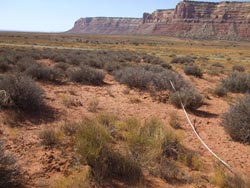Plant production could decline as climate change affects soil nutrients

The cliff face of Cedar Mesa, in southeast Utah, overlooks one of many sites sampled in the world's drylands. <br>
That includes people living in Arizona, who may be in for a dustier future.
The findings are presented in a study published in Nature that details how soil changes may occur and discusses the implications. Co-author Matthew Bowker, assistant professor of forest soils and ecosystem ecology at Northern Arizona University, was involved with the project since 2009.
Bowker explained that most of the 17 nutrients that plants need to grow to their potential are soil resources, such as nitrogen and phosphorus. The statistical model he helped develop for the study suggests that as the climate becomes more arid, nitrogen will decrease and phosphorus will increase.
“Both are essential for plant growth, and both are typical components of fertilizer, but both need to be around in the right quantities for plant growth to proceed most efficiently,” Bowker said.
“It’s like a situation where you’re making hamburgers but run out of beef. You can’t just slip in another bun and still produce a hamburger.”
Drylands, which are defined by predominantly lower levels of moisture, cover about 41 percent of the earth’s surface. The study suggests that people who depend on those ecosystems for crops, livestock forage, fuel and fiber will find their resources increasingly restrained.
In Arizona, Bowker said, the projected decrease in plant production could magnify the impact of dust storms, which have been increasing in recent decades.
“We can probably expect more and more dust in the air,” he said.
The project involved visits by research teams in 16 countries to 224 locations on every continent except Antarctica. Bowker led one of the sampling teams, which visited 10 study sites in northern Arizona and Utah. Those sites ranged from dry, grassy shrublands with low precipitation to relatively wet sagebrush ecosystems.
“This is a testament to the power of networked science,” Bowker said, adding that it would have been “prohibitively expensive” for any one researcher or research group to complete the project.
Media Contact
More Information:
http://www.nau.eduAll latest news from the category: Ecology, The Environment and Conservation
This complex theme deals primarily with interactions between organisms and the environmental factors that impact them, but to a greater extent between individual inanimate environmental factors.
innovations-report offers informative reports and articles on topics such as climate protection, landscape conservation, ecological systems, wildlife and nature parks and ecosystem efficiency and balance.
Newest articles

High-energy-density aqueous battery based on halogen multi-electron transfer
Traditional non-aqueous lithium-ion batteries have a high energy density, but their safety is compromised due to the flammable organic electrolytes they utilize. Aqueous batteries use water as the solvent for…

First-ever combined heart pump and pig kidney transplant
…gives new hope to patient with terminal illness. Surgeons at NYU Langone Health performed the first-ever combined mechanical heart pump and gene-edited pig kidney transplant surgery in a 54-year-old woman…

Biophysics: Testing how well biomarkers work
LMU researchers have developed a method to determine how reliably target proteins can be labeled using super-resolution fluorescence microscopy. Modern microscopy techniques make it possible to examine the inner workings…





















